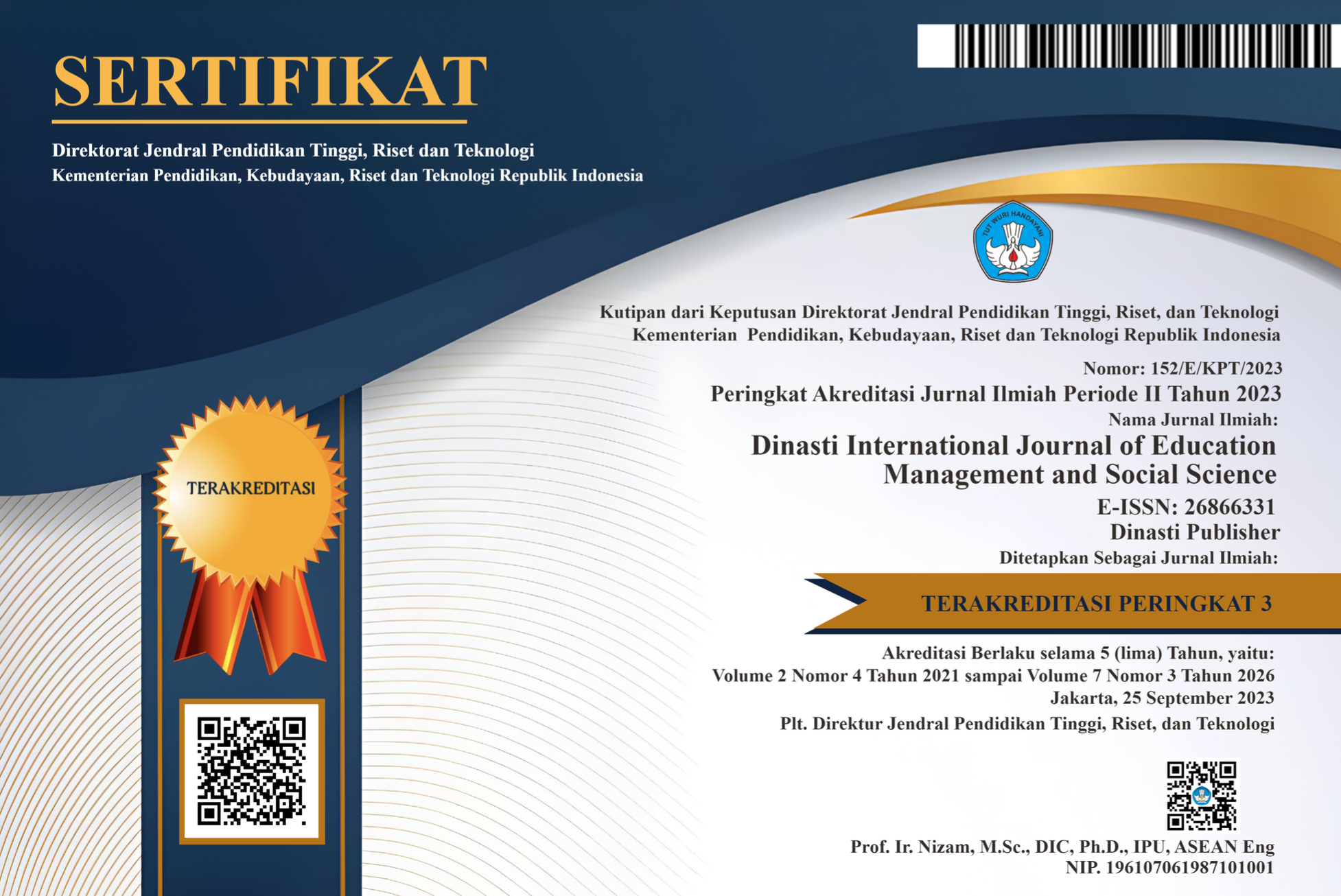Analysis of Intellectual Capital on Company Financial Performance in PT Reethau Cipta Energy
DOI:
https://doi.org/10.38035/dijemss.v5i3.2296Keywords:
Intellectual Capital, Financial Performance Return on Assets, Return on Investment, Revenue GrowthAbstract
The research aims to investigate the relationship between intellectual capital of the key resource-based components of the company (physical capital, human capital and structural capital) with financial performance using ROA (return on assets), ROI (returns on investment), and GR (growth revenue). The data is sobtained from the financial reports of the company PT Reethau Cipta Energi for the period 2019 – 2021 and the results of employee questionnaires on a Likert scale. This study tested three elements of VAIC (value added intellectual capital) and measures the financial performance of an enterprise using partial least squares (PLS) for data analysis that showed that: (1) Intellectual Capital has a significant influence on Return on Assets (ROA). Intellectual Capital Affects Return on Investment (ROI). (3) Intellectual capital has a significant impact on Revenue Growth (GR). (4) Intellectual capital has no significant influence on overall financial performance.
References
Abidin. 2000. "Efforts to Develop New Measures". Accounting Media. 7th Edition. Yr. VIII. pp. 46-47.
Armstrong, M. 2021. “Armstrong's handbook of strategic human resource management: improve business performance through strategic people management”. Seventh Edition.
Aufar, Raden. 2018. The Effect of Intellectual Capital on Company Value with Financial Performance as Intervening.
Baroroh, Niswah. 2013. Analysis of the Effect of Intellectual Capital on the Financial Performance of Manufacturing Companies in Indonesia. Journal of Accounting Dynamics, Vol. 5. No. 2. Pgs 172-182.
Bansaleng, RDV, Tommy, P., & Saerang, IS (2014). Debt Policy, Ownership Structure and Profitability on Dividend Policy in Food and Beverage Companies on the Indonesia Stock Exchange. EMBA Journal, Vol. 2(3), 817–830.
Chen, MC, SJ Cheng, Y. Hwang. 2005. “An empirical investigation of the relationship between intellectual capital and firms' market value and financial performance”. Journal of Intellectual Capital. Vol. 6 N0. 2.pp. 159-176
Chin, WW (1998). The partial least squares approach to structural equation modeling. Modern methods for business research, 295(2), 295-336.
Dasuki, RE, Resource, T., & View…, B. (2021). Coopetition: Scientific Journal of Management Strategy Management: Resource Based View Theory Study.
Dewantoro, A. and I. Thaib. (2017). The Effect of Profitability and Liquidity on Firm Value with Capital Structure as Intervening Variables. Journal of Banking Research Management and Accounting, Vol 1. No. 1
Fahmi, Irham. (2014). Corporate Financial Management and Capital Markets (1st ed). Jakarta: Media Discourse Partners.
Firer, S., and SM Williams. 2003. "Intellectual capital and traditional measures of corporate performance". Journal of Intellectual Capital. Vol. 4 No. 3.pp. 348-360.
Freeman, RE 2004. "Stakeholder Approach revisited". Zeitschrift für wirtschafts-und unternehmensethik. Vol. 5 No. 3.pp. 228-241.
Ghozali, I. 2006. Structural Equation Medeling; Alternative Method with PLS. Undip Publishing Agency. Semarang.
G, Alviani., and V. Purnamasari. (2011). The effect of intellectual capital on company performance: Balanced Scorecard Perspective. Journal of Business Accounting, Vol IX. No. 18 Indonesian Accountants Association. 2016. Statement of Financial Accounting Standards No. 19. Jakarta: Salemba Empat.
J, Barney. 1991. Firm Resources and Sustained Competitive Advantage. Journal of Management. Vols 17
Josephine, E. Trisnawati. 2019. The Effect of Intellectual Capital and Corporate Governance on Corporate Values Through Financial Performance. Muara Journal of Economics and Business, Vol 3. No.1. pp 59-70.
Joseph T Mahoney, JRP (1992). The Resource Based View Within The Conversation of Strategic Management. Strategic Management Journal, 13, 363–380.
Kaplan, Robert S, and David P. Norton. (1996). Linking the Balanced Scorecard to Strategy. California Management Reviews. Vol 39.No. 1
Kor, YY, & Mahoney, JT (2004). Edith Penrose's (1959) Contributions to the Resource Based View of Strategic Management. Journal of Management Studies, 41(1), 183–191. https://doi.org/10.1111/j.1467- 6486.2004.00427.
Md Husin, M., & Haron, R. (2020). Micro, small and medium enterprises' competitiveness and micro- tak?ful adoption. ISRA International Journal of Islamic Finance, 12(3), 367–380. https://doi.org/10.1108/IJIF-03-2019-0038.
M. Clarke., D. Seng, R. Whiting. 2010. “Intellectual capital and firm performance in Australia. Journal of Economic Literature. No. 12.
M, J, Marquardt. 2002. Building the Learning Organization. Second Edition.
Ningrum, FW (2018). The Influence of Intellectual Capital and Intellectual Capital Disclosure on Firm Value with Financial Performance as Intervening Variables. Journal of Accounting Science and Research. Volumes 7, Number6, 1-25.
Ousama, AA Hammami, Helmi. & Abdulkarim, M. (2019). The Association Between Intellectual Capital And Financial Performance In The Islamic Banking Industry. International Journal of Islamic and Middle Eastern Finance and Management. 13(1). 75-93. http://www.emerald.com
Paul, G. (2019). The Influence of Environmental Performance and Environmental Disclosure on Financial Performance (Study of Manufacturing Companies Registered in Bei). Economy. Vol. 14. No. 1, 31-40.
Pulic, A. 1998. "Measuring the Performance of Intellectual Potential in the Knowledge Economy." Presented in 1998 at the 2nd McMaster World Congress on Measuring and Managing Intellectual Capital: 1-20. Austria: The Austrian Team for Intellectual Potential.
Rachmawati, D. 2012. The Effect of Intellectual Capital on Banking Return On Assets (ROA). Nominal Journal: 34-40.
Sartika Aninditya, M., Wibowo Dwi Nugroho, S., Bambang Sunarko, and, Management, J., Economics and Business, F., & Jenderal Soedirman, U. (2022). Soedirman Economics Education Journal THE INFLUENCE OF INTELLECTUAL CAPITAL ON FINANCIAL PERFORMANCE IN MANUFACTURING COMPANIES LISTED ON THE INDONESIA STOCK EXCHANGE.
Sawarjuwono, T. 2003. "Intellectual capital: treatment, measurement, and reporting (a library research)". Journal of Accounting and Finance. Vol. 5 No. 1. pp. 35-57.
Spence, M. (2002). Signaling in retrospect and the informational structure of markets, American Economic Review, 92(3), 434-459.
Tan, HP, D. Plowman, P. Hancock. 2007. “Intellectual capital and financial returns of companies. Journal of Intellectual Capital. Vol. 8 No. 1.pp. 76-95.
Ulum, Ihyaul. 2008. Intellectual Capital Performance of the Banking Sector in Indonesia. Journal of Accounting and Finance, Vol. 10. No. 2. Pgs 77-84.
Wernerfelt, B. (2003). A resource-based view of the firm. International Library of Critical Writings in Economics. 163: 276-285.
Widarjo, W. (2011). The effect of intellectual capital and disclosure of intellectual capital on the value of companies conducting Initial Public Offerings. Indonesian Journal of Accounting and Finance, 8(2), 157-170.
Wulandari, N. (2022). The Influence of Leadership Style and Client Interests on Dysfunctional Audit Behavior. 5: 42-51.
Yudha, DS, and M. Nasir. 2012. Analysis of the Influence of Intellectual Capital Components on Investor Trust and Reaction: Case Studies of Companies Listed on the Indonesian Stock Exchange. Diponegoro Journal of Accounting: 1-15.
Downloads
Published
How to Cite
Issue
Section
License
Copyright (c) 2024 Luthfi Hanif Pratama, Oetami Prasadjaningsih

This work is licensed under a Creative Commons Attribution 4.0 International License.
Authors who publish their manuscripts in this journal agree to the following conditions:
- The copyright on each article belongs to the author(s).
- The author acknowledges that the Dinasti International Journal of Education Management and Social Science (DIJEMSS) has the right to be the first to publish with a Creative Commons Attribution 4.0 International license (Attribution 4.0 International (CC BY 4.0).
- Authors can submit articles separately, arrange for the non-exclusive distribution of manuscripts that have been published in this journal into other versions (e.g., sent to the author's institutional repository, publication into books, etc.), by acknowledging that the manuscript has been published for the first time in the Dinasti International Journal of Education Management and Social Science (DIJEMSS).















































